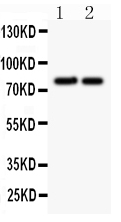Anti-Gamma Catenin Antibody
- SPECIFICATION
- CITATIONS
- PROTOCOLS
- BACKGROUND

Application
| WB |
|---|---|
| Primary Accession | P14923 |
| Host | Rabbit |
| Reactivity | Human, Mouse, Rat |
| Clonality | Polyclonal |
| Format | Lyophilized |
| Description | Rabbit IgG polyclonal antibody for Junction plakoglobin(JUP) detection. Tested with WB in Human;Mouse;Rat. |
| Reconstitution | Add 0.2ml of distilled water will yield a concentration of 500ug/ml. |
| Gene ID | 3728 |
|---|---|
| Other Names | Junction plakoglobin, Catenin gamma, Desmoplakin III, Desmoplakin-3, JUP, CTNNG, DP3 |
| Calculated MW | 81745 MW KDa |
| Application Details | Western blot, 0.1-0.5 µg/ml, Human, Mouse, Rat |
| Subcellular Localization | Cell junction, adherens junction . Cell junction, desmosome . Cytoplasm, cytoskeleton . Membrane ; Peripheral membrane protein . Cytoplasmic in a soluble and membrane-associated form. |
| Protein Name | Junction plakoglobin |
| Contents | Each vial contains 5mg BSA, 0.9mg NaCl, 0.2mg Na2HPO4, 0.05mg Thimerosal, 0.05mg NaN3. |
| Immunogen | A synthetic peptide corresponding to a sequence at the N-terminus of human gamma Catenin(101-118aa LLATQVEGQATNLQRLAE), different from the related mouse and rat sequences by one amino acid. |
| Purification | Immunogen affinity purified. |
| Cross Reactivity | No cross reactivity with other proteins |
| Storage | At -20˚C for one year. After r˚Constitution, at 4˚C for one month. It˚Can also be aliquotted and stored frozen at -20˚C for a longer time.Avoid repeated freezing and thawing. |
| Sequence Similarities | Belongs to the beta-catenin family. |
| Name | JUP (HGNC:6207) |
|---|---|
| Function | Common junctional plaque protein. The membrane-associated plaques are architectural elements in an important strategic position to influence the arrangement and function of both the cytoskeleton and the cells within the tissue. The presence of plakoglobin in both the desmosomes and in the intermediate junctions suggests that it plays a central role in the structure and function of submembranous plaques. Acts as a substrate for VE-PTP and is required by it to stimulate VE- cadherin function in endothelial cells. Can replace beta-catenin in E- cadherin/catenin adhesion complexes which are proposed to couple cadherins to the actin cytoskeleton (By similarity). |
| Cellular Location | Cell junction, adherens junction. Cell junction, desmosome. Cytoplasm, cytoskeleton. Cell membrane; Peripheral membrane protein. Cytoplasm {ECO:0000250|UniProtKB:Q9PVF7}. Cell junction {ECO:0000250|UniProtKB:Q9PVF7}. Nucleus {ECO:0000250|UniProtKB:Q9PVF7} Note=Cytoplasmic in a soluble and membrane-associated form. Colocalizes with DSG4 at desmosomes (PubMed:21495994) |
| Tissue Location | Expressed in the heart (at protein level). |

Thousands of laboratories across the world have published research that depended on the performance of antibodies from Abcepta to advance their research. Check out links to articles that cite our products in major peer-reviewed journals, organized by research category.
info@abcepta.com, and receive a free "I Love Antibodies" mug.
Provided below are standard protocols that you may find useful for product applications.
Background
Cateningamma, also known as junction plakoglobin(JUP) or plakoglobin(PKGB). Plakoglobin is a major cytoplasmic protein which is the only known constituent common to submembranous plaques of both desmosomes and intermediate junctions. Cateninbeta and cateningamma(plakoglobin), vertebrate homologs of Drosophila armadillo, function in cell adhesion and the Wnt signaling pathway. Cateningamma may have distinct roles in Wnt signaling and cancer via differential effects on downstream target genes.
If you have used an Abcepta product and would like to share how it has performed, please click on the "Submit Review" button and provide the requested information. Our staff will examine and post your review and contact you if needed.
If you have any additional inquiries please email technical services at tech@abcepta.com.













 Foundational characteristics of cancer include proliferation, angiogenesis, migration, evasion of apoptosis, and cellular immortality. Find key markers for these cellular processes and antibodies to detect them.
Foundational characteristics of cancer include proliferation, angiogenesis, migration, evasion of apoptosis, and cellular immortality. Find key markers for these cellular processes and antibodies to detect them. The SUMOplot™ Analysis Program predicts and scores sumoylation sites in your protein. SUMOylation is a post-translational modification involved in various cellular processes, such as nuclear-cytosolic transport, transcriptional regulation, apoptosis, protein stability, response to stress, and progression through the cell cycle.
The SUMOplot™ Analysis Program predicts and scores sumoylation sites in your protein. SUMOylation is a post-translational modification involved in various cellular processes, such as nuclear-cytosolic transport, transcriptional regulation, apoptosis, protein stability, response to stress, and progression through the cell cycle. The Autophagy Receptor Motif Plotter predicts and scores autophagy receptor binding sites in your protein. Identifying proteins connected to this pathway is critical to understanding the role of autophagy in physiological as well as pathological processes such as development, differentiation, neurodegenerative diseases, stress, infection, and cancer.
The Autophagy Receptor Motif Plotter predicts and scores autophagy receptor binding sites in your protein. Identifying proteins connected to this pathway is critical to understanding the role of autophagy in physiological as well as pathological processes such as development, differentiation, neurodegenerative diseases, stress, infection, and cancer.


